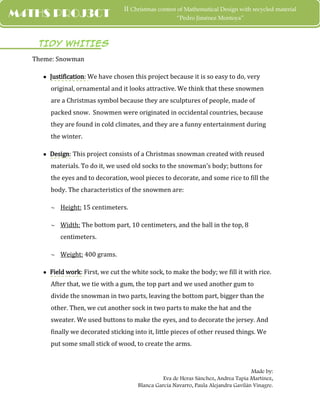
Tidy whities gavilán, g navarro, de heras, tapia martinez
- 1. II Christmas contest of Mathematical Design with recycled material M4THS PROJ3CT “Pedro Jiménez Montoya” TIDY WHITIES Theme: Snowman Justification: We have chosen this project because it is so easy to do, very original, ornamental and it looks attractive. We think that these snowmen are a Christmas symbol because they are sculptures of people, made of packed snow. Snowmen were originated in occidental countries, because they are found in cold climates, and they are a funny entertainment during the winter. Design: This project consists of a Christmas snowman created with reused materials. To do it, we used old socks to the snowman’s body; buttons for the eyes and to decoration, wool pieces to decorate, and some rice to fill the body. The characteristics of the snowmen are: Height: 15 centimeters. Width: The bottom part, 10 centimeters, and the ball in the top, 8 centimeters. Weight: 400 grams. Field work: First, we cut the white sock, to make the body; we fill it with rice. After that, we tie with a gum, the top part and we used another gum to divide the snowman in two parts, leaving the bottom part, bigger than the other. Then, we cut another sock in two parts to make the hat and the sweater. We used buttons to make the eyes, and to decorate the jersey. And finally we decorated sticking into it, little pieces of other reused things. We put some small stick of wood, to create the arms. Made by: Eva de Heras Sánchez, Andrea Tapia Martínez, Blanca García Navarro, Paula Alejandra Gavilán Vinagre.
- 2. II Christmas contest of Mathematical Design with recycled material M4THS PROJ3CT “Pedro Jiménez Montoya” Budget: We only ought the rice, because the others materials were reused. If we had bought the things, the snowman would had cost an euro more or less. We bought the cheapest rice. (0'77 € per kilogram). Time: To make this project, we spent two evenings. In one of them, we met in Eva's house to think about what we were going to create. First, we tough to do an angel to put on a Christmas tree, but then, we decided to do these snowmen. During the first evening, we spent two hours designing the project of the angels, so the next day, we had to start a new project about the snowmen. We were doing this, two hours at least. And we finally finish it during the night. So, totally we had spent four hours to create this project. More information about the snowmen: The practice of making snowmen dates back to at least the Middle Ages, and it may be even older, given the fact that snow is ideally suited to sculpting, especially for young and inexperienced hands. A classic snowman is made very simply, with three balls of snow stacked on top of each other. Traditionally, the balls taper in size, with the top ball forming the head, the middle ball forming the torso, and the bottom ball being used for the legs. It is also common to decorate the snowman, classically with lumps of coal for eyes and a carrot for a nose. Coal may also be used to suggest buttons on the snowman's torso, and to make a mouth. Sticks may be used to suggest arms, and some snowmen also wear hats, scarves, and gloves. The basic form of the snowman is subject to variation, of course. At some traditional snow festivals, for example, snowmen are made with two balls of Made by: Eva de Heras Sánchez, Andrea Tapia Martínez, Blanca García Navarro, Paula Alejandra Gavilán Vinagre.
- 3. II Christmas contest of Mathematical Design with recycled material M4THS PROJ3CT “Pedro Jiménez Montoya” snow for convenience, and they may be made very small. In Japan, some snow festivals result in hundreds of tiny snowmen lined up in fields and other public places, which can be quite a sight. People can also try to give snowmen more realistic features like actual legs, and in some cases they may be supported with an internal framework. Depending on weather conditions, a snowman may be ephemeral or enduring. If the weather stays cold and dry, a snowman can continue to exist for a prolonged period of time, although he may start to get a bit crumbly. If more snow falls, the snowman may become slightly buried, although people can repack the snow to reshape him. In rain or warming weather, the snowman melts away, leaving his accessories behind. Many people in snowy countries enjoy making snowmen as a winter activity which allows them to get outside even when the weather is less than ideal. After a period of heavy snow, it is not uncommon to see numerous people out and about in their yards, taking stock of damage and cooperating in teams to build snowmen for fun. Although many people associate making snowmen with childhood games, adults are often involved as well, and in some regions adults hold competitions for the best snowman. Made by: Eva de Heras Sánchez, Andrea Tapia Martínez, Blanca García Navarro, Paula Alejandra Gavilán Vinagre.